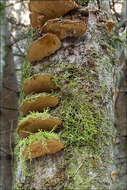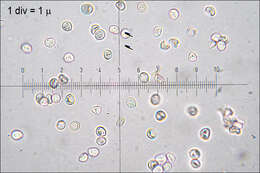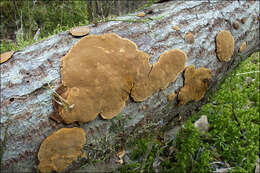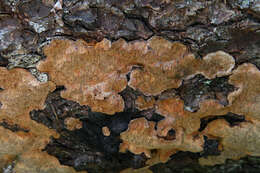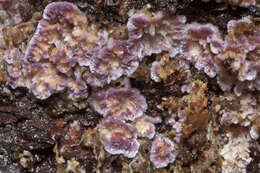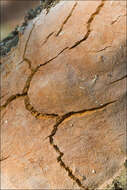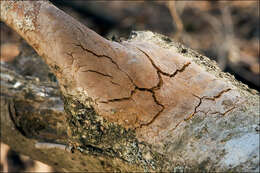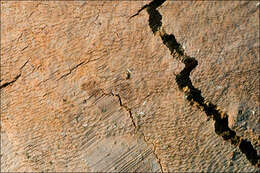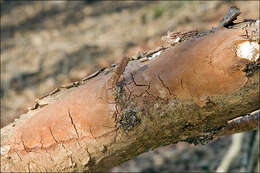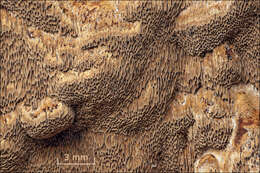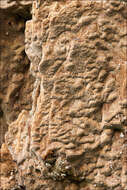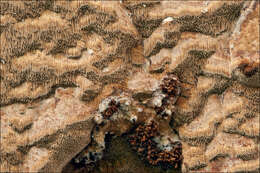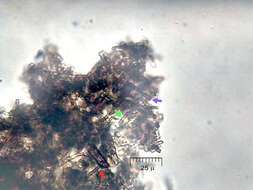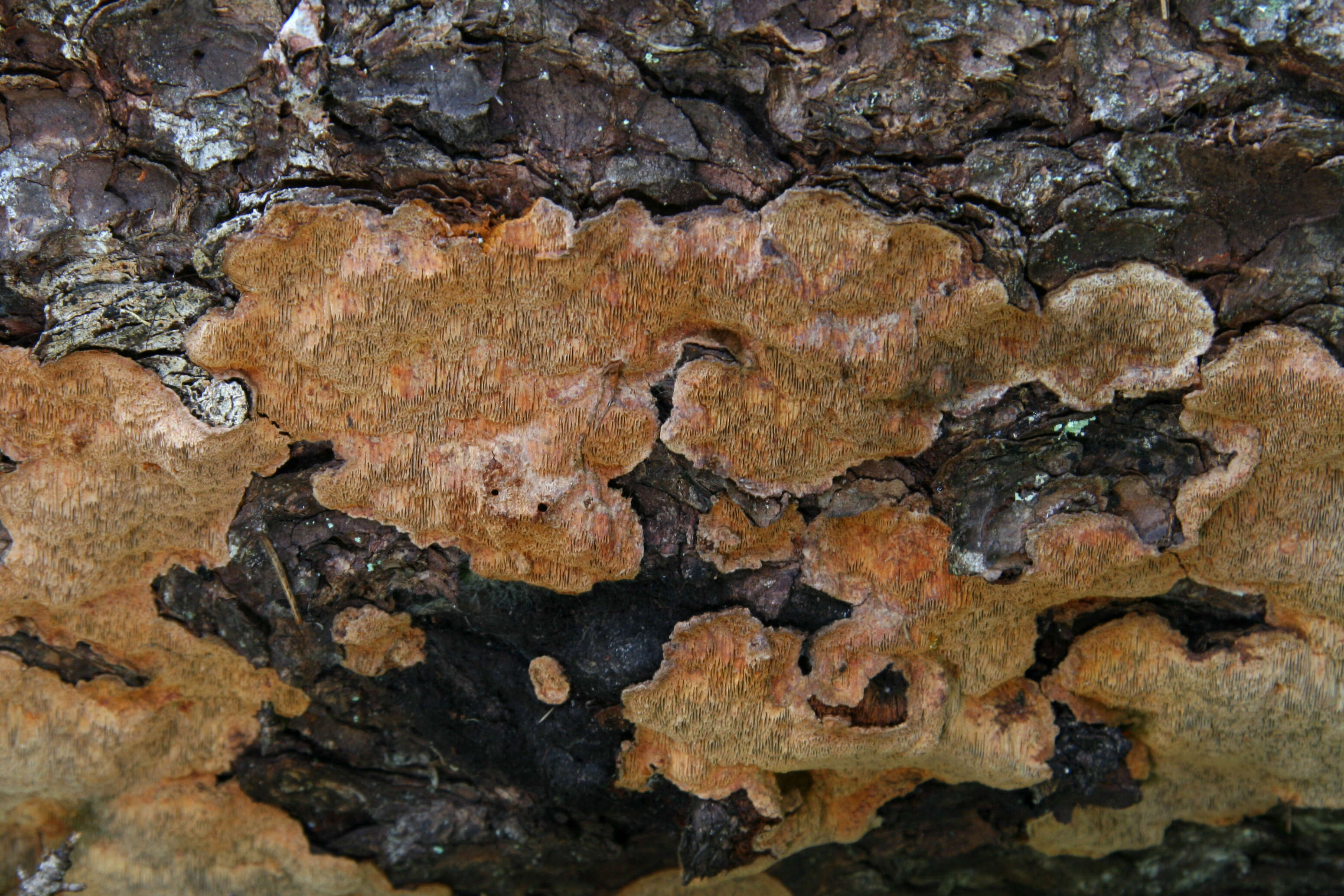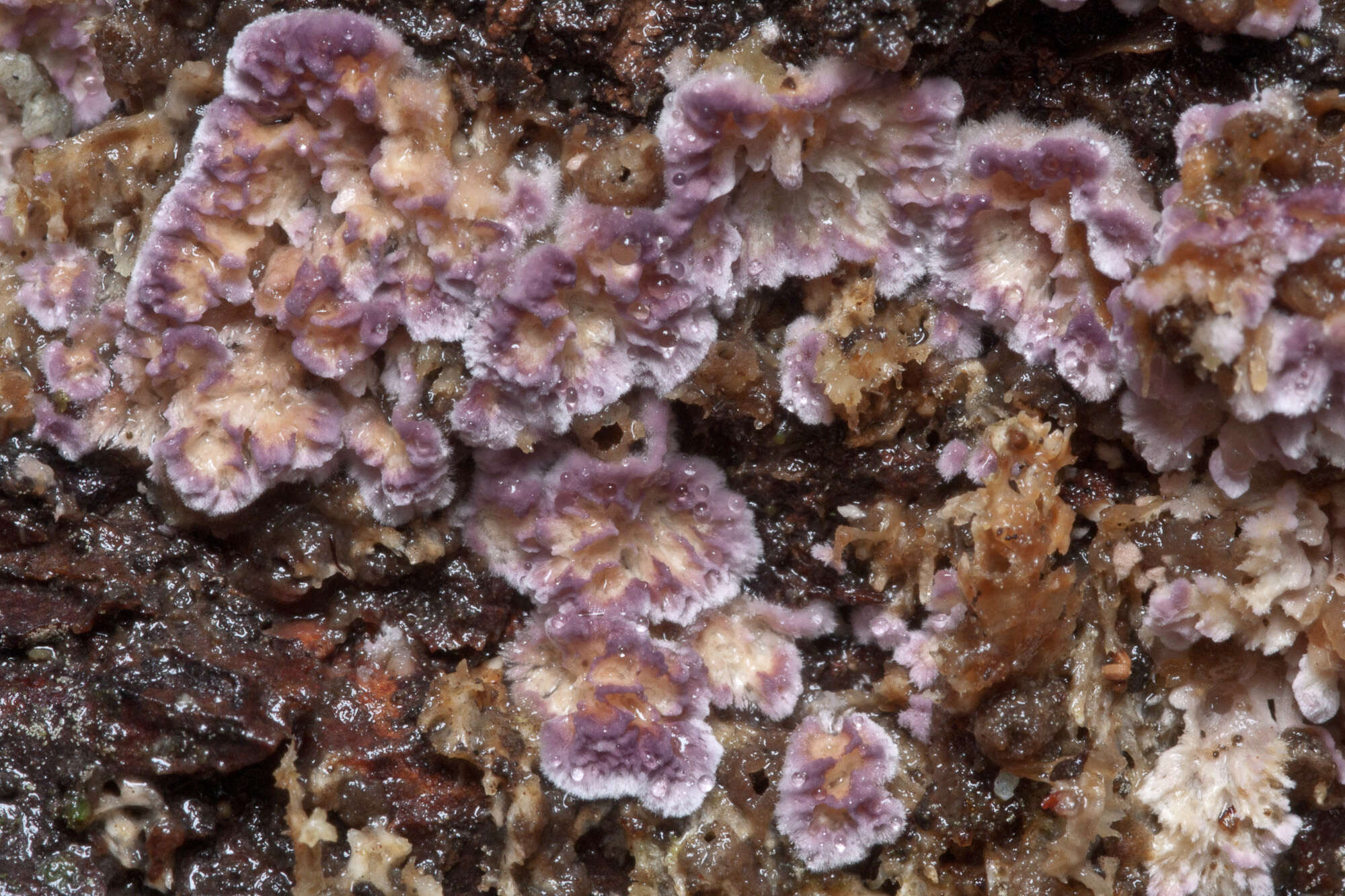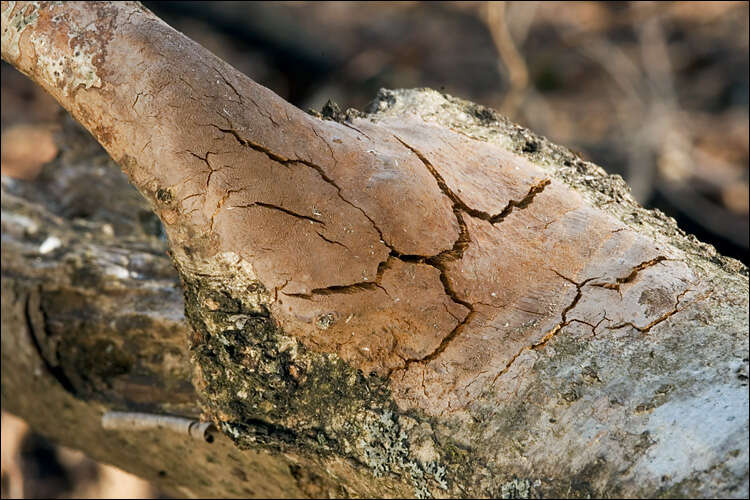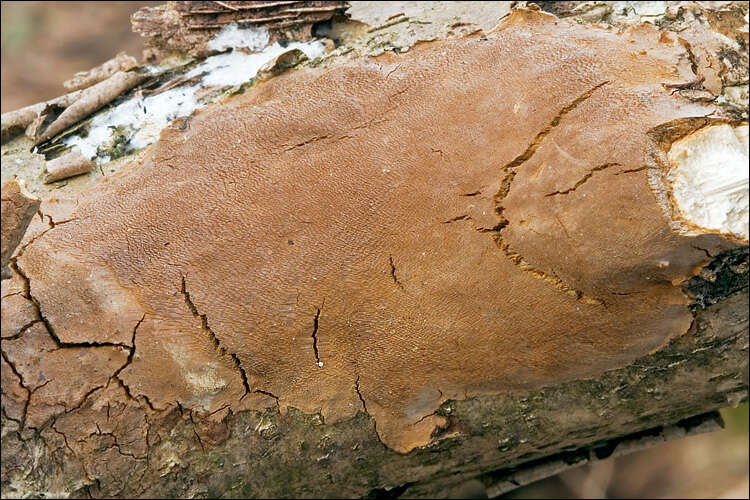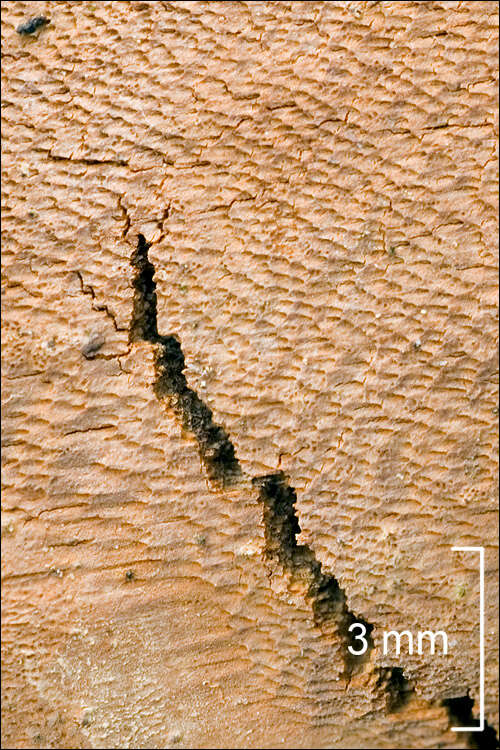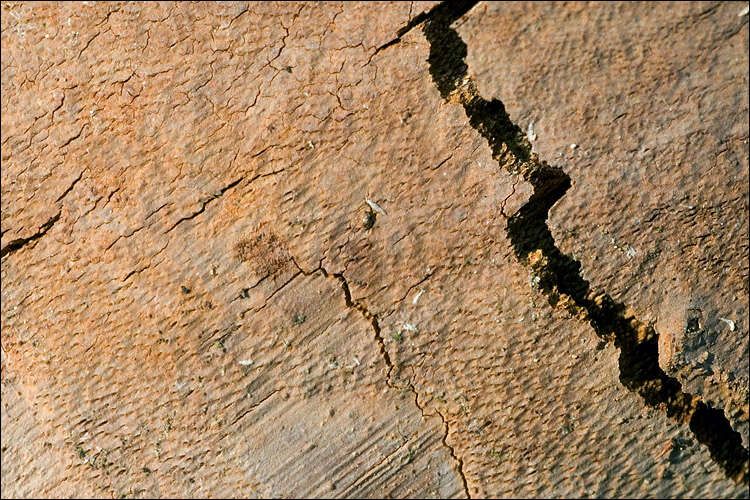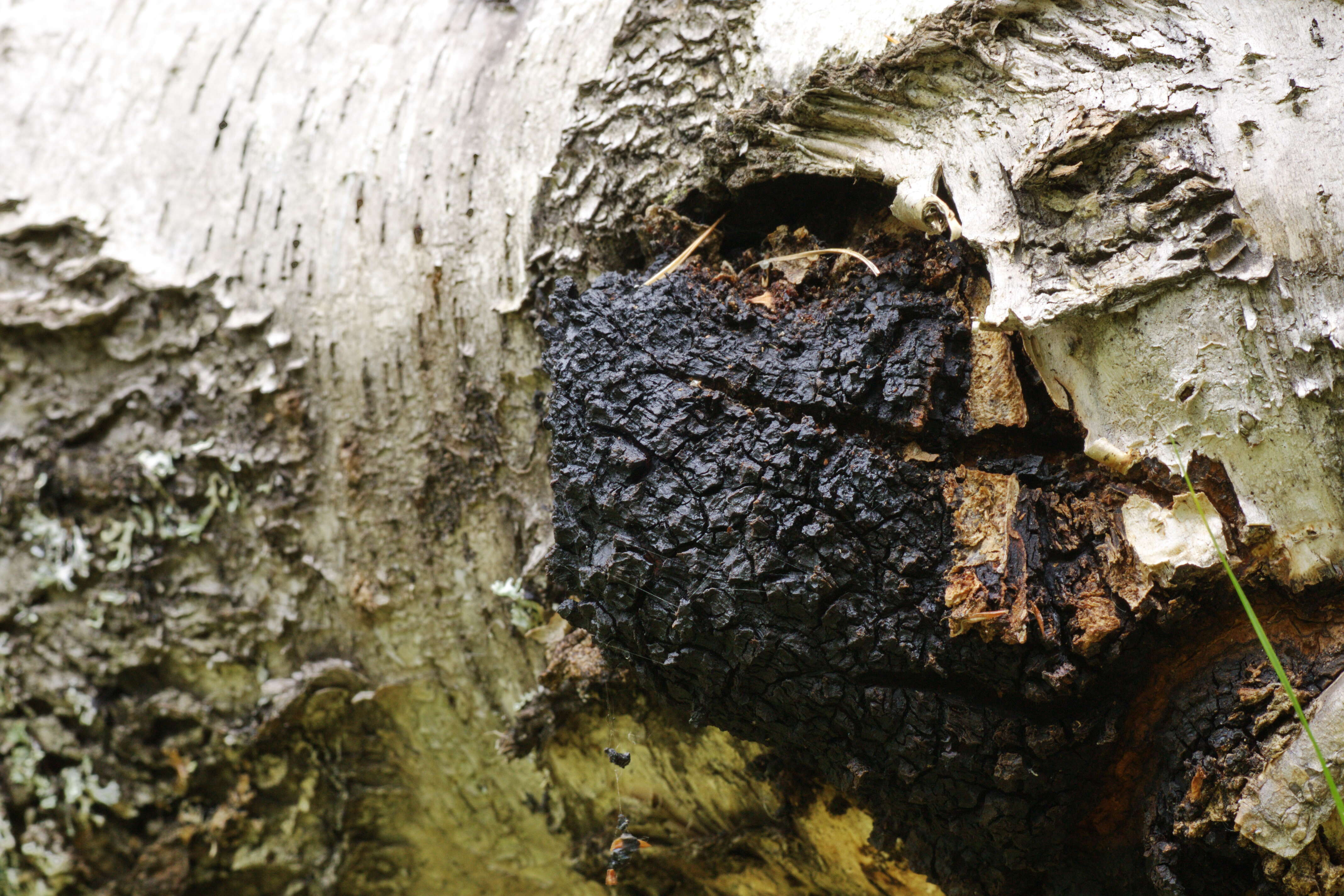-
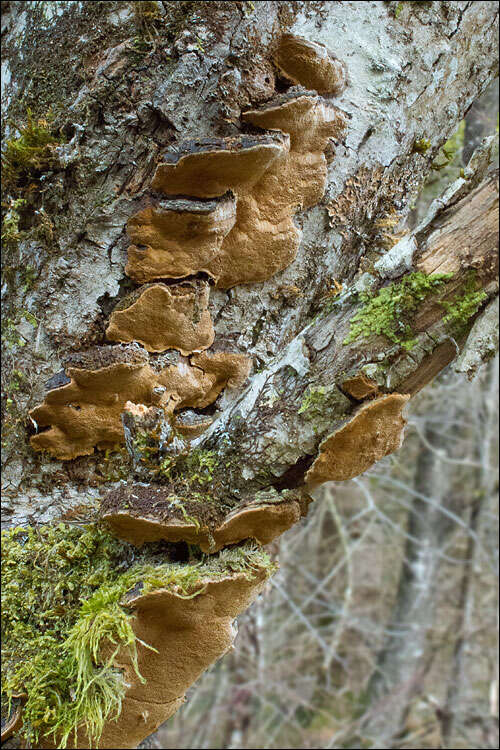
Phellinus conchatusSlo.: koljkasti plutaPhellinus conchatusSlo.: koljkasti plutaDat.: Jan. 30. 20121.Lat.: 46.33677 Long.: 13.63265Code: Bot_593/2012_IMG8496 2.Lat.: 46.33642 Long.: 13.63371Code: Bot_593/2012_IMG5817 Habitat: River shore, mixed forest, dominant Salix eleagnos and Picea abies; young alluvial calcareous river deposits, flat terrain, shallow soil, high ground and air humidity, in shade, partly protected from direct rain by tree canopies, average precipitations ~ 3.000 mm/year, average temperature 7-9 deg C, elevation 420 m (1.400 feet), alpine phytogeographical region.Substratum: dead, in initial stage of disintegration, still standing or hanging broken, still in bark trunk of Salix eleagnos.Place: Lower Trenta valley, downstream of confluence of river Soa and Lepenica stream, right bank of river Soa, East Julian Alps, Posoje, Slovenia EC Comments: Photographed in relative dry state, temperatures below 0 deg C for a few consecutive days; found 0.5 to 2 m above ground, several basidiocarps from pure resupinated to pure pileate form; found on several Salix trees also on the left bank of river Soa; pileus diameter up to 10 cm (4 inch), smell indistinctive, flesh hard, corky, hard to cut; SP too faint to judge the color, obtained only after keeping pilei at room temperature and 100% relative air humidity. Spores smooth, dimensions: 5.4 (SD = 0.2) x 4.5 (SD = 0.3) micr., Q = 1.19 (SD = 0.09), n = 30.Ref.:(1) A.Bernicchia, Polyporaceae s.l., Fungi Europaei, Vol. 10., Edizioni Candusso (2005), p 400. 4-5/4-4.5 (2) G.J.Krieglsteiner (Hrsg.), Die Grosspilze Bade-Wrttembergs, Band 1, Ulmer (2000), p 448. (3) Ryvarden, L.; Gilbertson, R.L. 1994, Syn. Fung. 7: p479 (after MicoBank)
-

Phellinus conchatusSlo.: koljkasti plutaDat.: Jan. 30. 20121.Lat.: 46.33677 Long.: 13.63265Code: Bot_593/2012_IMG8496 2.Lat.: 46.33642 Long.: 13.63371Code: Bot_593/2012_IMG5817 Habitat: River shore, mixed forest, dominant Salix eleagnos and Picea abies; young alluvial calcareous river deposits, flat terrain, shallow soil, high ground and air humidity, in shade, partly protected from direct rain by tree canopies, average precipitations ~ 3.000 mm/year, average temperature 7-9 deg C, elevation 420 m (1.400 feet), alpine phytogeographical region.Substratum: dead, in initial stage of disintegration, still standing or hanging broken, still in bark trunk of Salix eleagnos.Place: Lower Trenta valley, downstream of confluence of river Soa and Lepenica stream, right bank of river Soa, East Julian Alps, Posoje, Slovenia EC Comments: Photographed in relative dry state, temperatures below 0 deg C for a few consecutive days; found 0.5 to 2 m above ground, several basidiocarps from pure resupinated to pure pileate form; found on several Salix trees also on the left bank of river Soa; pileus diameter up to 10 cm (4 inch), smell indistinctive, flesh hard, corky, hard to cut; SP too faint to judge the color, obtained only after keeping pilei at room temperature and 100% relative air humidity. Spores smooth, dimensions: 5.4 (SD = 0.2) x 4.5 (SD = 0.3) micr., Q = 1.19 (SD = 0.09), n = 30.Ref.:(1) A.Bernicchia, Polyporaceae s.l., Fungi Europaei, Vol. 10., Edizioni Candusso (2005), p 400. 4-5/4-4.5 (2) G.J.Krieglsteiner (Hrsg.), Die Grosspilze Bade-Wrttembergs, Band 1, Ulmer (2000), p 448. (3) Ryvarden, L.; Gilbertson, R.L. 1994, Syn. Fung. 7: p479 (after MicoBank)
-

Phellinus conchatusSlo.: koljkasti plutaDat.: Jan. 30. 20121.Lat.: 46.33677 Long.: 13.63265Code: Bot_593/2012_IMG8496 2.Lat.: 46.33642 Long.: 13.63371Code: Bot_593/2012_IMG5817 Habitat: River shore, mixed forest, dominant Salix eleagnos and Picea abies; young alluvial calcareous river deposits, flat terrain, shallow soil, high ground and air humidity, in shade, partly protected from direct rain by tree canopies, average precipitations ~ 3.000 mm/year, average temperature 7-9 deg C, elevation 420 m (1.400 feet), alpine phytogeographical region.Substratum: dead, in initial stage of disintegration, still standing or hanging broken, still in bark trunk of Salix eleagnos.Place: Lower Trenta valley, downstream of confluence of river Soa and Lepenica stream, right bank of river Soa, East Julian Alps, Posoje, Slovenia EC Comments: Photographed in relative dry state, temperatures below 0 deg C for a few consecutive days; found 0.5 to 2 m above ground, several basidiocarps from pure resupinated to pure pileate form; found on several Salix trees also on the left bank of river Soa; pileus diameter up to 10 cm (4 inch), smell indistinctive, flesh hard, corky, hard to cut; SP too faint to judge the color, obtained only after keeping pilei at room temperature and 100% relative air humidity. Spores smooth, dimensions: 5.4 (SD = 0.2) x 4.5 (SD = 0.3) micr., Q = 1.19 (SD = 0.09), n = 30.Ref.:(1) A.Bernicchia, Polyporaceae s.l., Fungi Europaei, Vol. 10., Edizioni Candusso (2005), p 400. 4-5/4-4.5 (2) G.J.Krieglsteiner (Hrsg.), Die Grosspilze Bade-Wrttembergs, Band 1, Ulmer (2000), p 448. (3) Ryvarden, L.; Gilbertson, R.L. 1994, Syn. Fung. 7: p479 (after MicoBank)
-
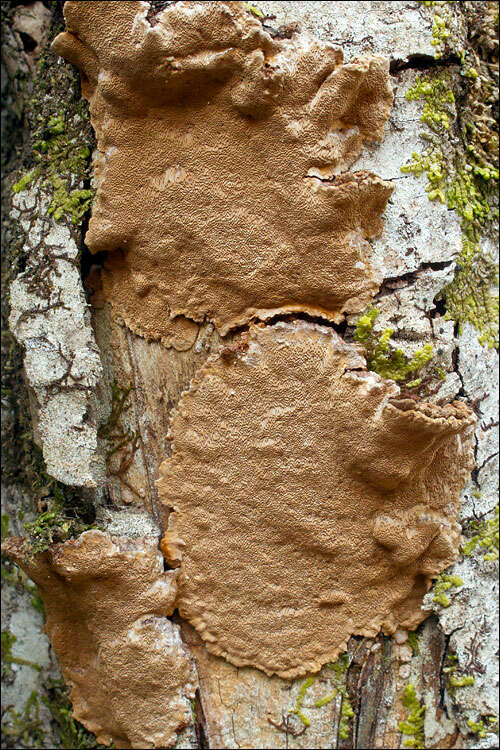
Phellinus conchatusSlo.: koljkasti plutaDat.: Jan. 30. 20121.Lat.: 46.33677 Long.: 13.63265Code: Bot_593/2012_IMG8496 2.Lat.: 46.33642 Long.: 13.63371Code: Bot_593/2012_IMG5817 Habitat: River shore, mixed forest, dominant Salix eleagnos and Picea abies; young alluvial calcareous river deposits, flat terrain, shallow soil, high ground and air humidity, in shade, partly protected from direct rain by tree canopies, average precipitations ~ 3.000 mm/year, average temperature 7-9 deg C, elevation 420 m (1.400 feet), alpine phytogeographical region.Substratum: dead, in initial stage of disintegration, still standing or hanging broken, still in bark trunk of Salix eleagnos.Place: Lower Trenta valley, downstream of confluence of river Soa and Lepenica stream, right bank of river Soa, East Julian Alps, Posoje, Slovenia EC Comments: Photographed in relative dry state, temperatures below 0 deg C for a few consecutive days; found 0.5 to 2 m above ground, several basidiocarps from pure resupinated to pure pileate form; found on several Salix trees also on the left bank of river Soa; pileus diameter up to 10 cm (4 inch), smell indistinctive, flesh hard, corky, hard to cut; SP too faint to judge the color, obtained only after keeping pilei at room temperature and 100% relative air humidity. Spores smooth, dimensions: 5.4 (SD = 0.2) x 4.5 (SD = 0.3) micr., Q = 1.19 (SD = 0.09), n = 30.Ref.:(1) A.Bernicchia, Polyporaceae s.l., Fungi Europaei, Vol. 10., Edizioni Candusso (2005), p 400. 4-5/4-4.5 (2) G.J.Krieglsteiner (Hrsg.), Die Grosspilze Bade-Wrttembergs, Band 1, Ulmer (2000), p 448. (3) Ryvarden, L.; Gilbertson, R.L. 1994, Syn. Fung. 7: p479 (after MicoBank)
-
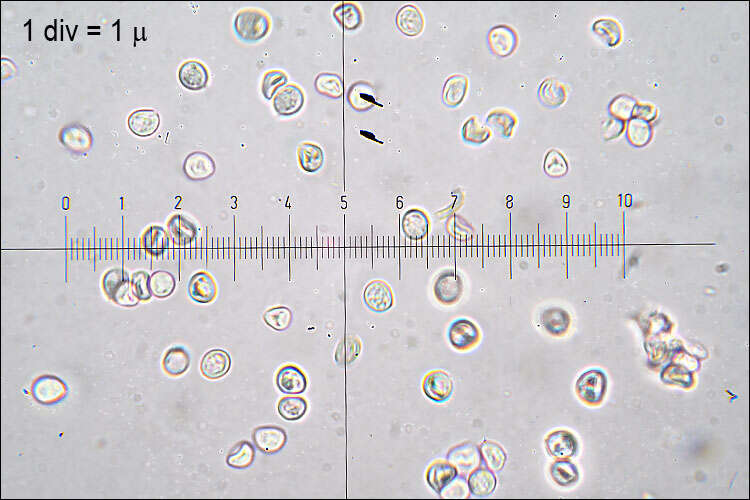
Phellinus conchatusSlo.: koljkasti plutaDat.: Jan. 30. 20121.Lat.: 46.33677 Long.: 13.63265Code: Bot_593/2012_IMG8496 2.Lat.: 46.33642 Long.: 13.63371Code: Bot_593/2012_IMG5817 Habitat: River shore, mixed forest, dominant Salix eleagnos and Picea abies; young alluvial calcareous river deposits, flat terrain, shallow soil, high ground and air humidity, in shade, partly protected from direct rain by tree canopies, average precipitations ~ 3.000 mm/year, average temperature 7-9 deg C, elevation 420 m (1.400 feet), alpine phytogeographical region.Substratum: dead, in initial stage of disintegration, still standing or hanging broken, still in bark trunk of Salix eleagnos.Place: Lower Trenta valley, downstream of confluence of river Soa and Lepenica stream, right bank of river Soa, East Julian Alps, Posoje, Slovenia EC Comments: Photographed in relative dry state, temperatures below 0 deg C for a few consecutive days; found 0.5 to 2 m above ground, several basidiocarps from pure resupinated to pure pileate form; found on several Salix trees also on the left bank of river Soa; pileus diameter up to 10 cm (4 inch), smell indistinctive, flesh hard, corky, hard to cut; SP too faint to judge the color, obtained only after keeping pilei at room temperature and 100% relative air humidity. Spores smooth, dimensions: 5.4 (SD = 0.2) x 4.5 (SD = 0.3) micr., Q = 1.19 (SD = 0.09), n = 30. Motic B2-211A, magnification 1.000 x, oil, in water. Congo Red. Ref.:(1) A.Bernicchia, Polyporaceae s.l., Fungi Europaei, Vol. 10., Edizioni Candusso (2005), p 400. 4-5/4-4.5 (2) G.J.Krieglsteiner (Hrsg.), Die Grosspilze Bade-Wrttembergs, Band 1, Ulmer (2000), p 448. (3) Ryvarden, L.; Gilbertson, R.L. 1994, Syn. Fung. 7: p479 (after MicoBank)
-

Phellinus conchatusSlo.: koljkasti plutaDat.: Jan. 30. 20121.Lat.: 46.33677 Long.: 13.63265Code: Bot_593/2012_IMG8496 2.Lat.: 46.33642 Long.: 13.63371Code: Bot_593/2012_IMG5817 Habitat: River shore, mixed forest, dominant Salix eleagnos and Picea abies; young alluvial calcareous river deposits, flat terrain, shallow soil, high ground and air humidity, in shade, partly protected from direct rain by tree canopies, average precipitations ~ 3.000 mm/year, average temperature 7-9 deg C, elevation 420 m (1.400 feet), alpine phytogeographical region.Substratum: dead, in initial stage of disintegration, still standing or hanging broken, still in bark trunk of Salix eleagnos.Place: Lower Trenta valley, downstream of confluence of river Soa and Lepenica stream, right bank of river Soa, East Julian Alps, Posoje, Slovenia EC Comments: Photographed in relative dry state, temperatures below 0 deg C for a few consecutive days; found 0.5 to 2 m above ground, several basidiocarps from pure resupinated to pure pileate form; found on several Salix trees also on the left bank of river Soa; pileus diameter up to 10 cm (4 inch), smell indistinctive, flesh hard, corky, hard to cut; SP too faint to judge the color, obtained only after keeping pilei at room temperature and 100% relative air humidity. Spores smooth, dimensions: 5.4 (SD = 0.2) x 4.5 (SD = 0.3) micr., Q = 1.19 (SD = 0.09), n = 30.Ref.:(1) A.Bernicchia, Polyporaceae s.l., Fungi Europaei, Vol. 10., Edizioni Candusso (2005), p 400. 4-5/4-4.5 (2) G.J.Krieglsteiner (Hrsg.), Die Grosspilze Bade-Wrttembergs, Band 1, Ulmer (2000), p 448. (3) Ryvarden, L.; Gilbertson, R.L. 1994, Syn. Fung. 7: p479 (after MicoBank)
-

Phellinus conchatusSlo.: koljkasti plutaDat.: Jan. 30. 20121.Lat.: 46.33677 Long.: 13.63265Code: Bot_593/2012_IMG8496 2.Lat.: 46.33642 Long.: 13.63371Code: Bot_593/2012_IMG5817 Habitat: River shore, mixed forest, dominant Salix eleagnos and Picea abies; young alluvial calcareous river deposits, flat terrain, shallow soil, high ground and air humidity, in shade, partly protected from direct rain by tree canopies, average precipitations ~ 3.000 mm/year, average temperature 7-9 deg C, elevation 420 m (1.400 feet), alpine phytogeographical region.Substratum: dead, in initial stage of disintegration, still standing or hanging broken, still in bark trunk of Salix eleagnos.Place: Lower Trenta valley, downstream of confluence of river Soa and Lepenica stream, right bank of river Soa, East Julian Alps, Posoje, Slovenia EC Comments: Photographed in relative dry state, temperatures below 0 deg C for a few consecutive days; found 0.5 to 2 m above ground, several basidiocarps from pure resupinated to pure pileate form; found on several Salix trees also on the left bank of river Soa; pileus diameter up to 10 cm (4 inch), smell indistinctive, flesh hard, corky, hard to cut; SP too faint to judge the color, obtained only after keeping pilei at room temperature and 100% relative air humidity. Spores smooth, dimensions: 5.4 (SD = 0.2) x 4.5 (SD = 0.3) micr., Q = 1.19 (SD = 0.09), n = 30.Ref.:(1) A.Bernicchia, Polyporaceae s.l., Fungi Europaei, Vol. 10., Edizioni Candusso (2005), p 400. 4-5/4-4.5 (2) G.J.Krieglsteiner (Hrsg.), Die Grosspilze Bade-Wrttembergs, Band 1, Ulmer (2000), p 448. (3) Ryvarden, L.; Gilbertson, R.L. 1994, Syn. Fung. 7: p479 (after MicoBank)
-
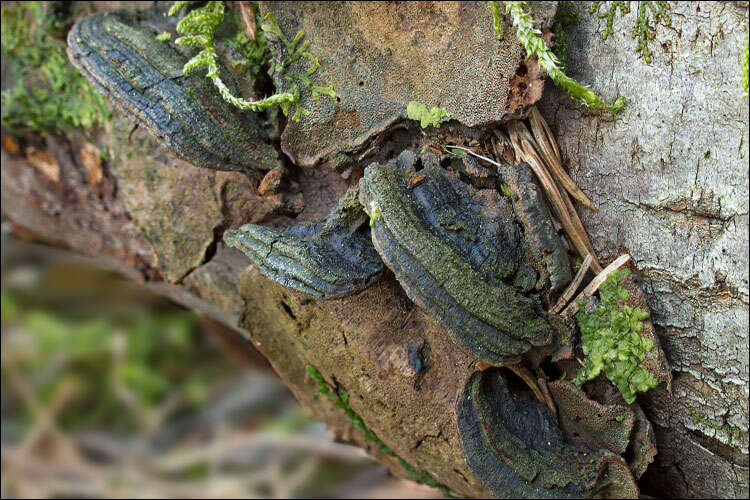
Phellinus conchatusSlo.: koljkasti plutaDat.: Jan. 30. 20121.Lat.: 46.33677 Long.: 13.63265Code: Bot_593/2012_IMG8496 2.Lat.: 46.33642 Long.: 13.63371Code: Bot_593/2012_IMG5817 Habitat: River shore, mixed forest, dominant Salix eleagnos and Picea abies; young alluvial calcareous river deposits, flat terrain, shallow soil, high ground and air humidity, in shade, partly protected from direct rain by tree canopies, average precipitations ~ 3.000 mm/year, average temperature 7-9 deg C, elevation 420 m (1.400 feet), alpine phytogeographical region.Substratum: dead, in initial stage of disintegration, still standing or hanging broken, still in bark trunk of Salix eleagnos.Place: Lower Trenta valley, downstream of confluence of river Soa and Lepenica stream, right bank of river Soa, East Julian Alps, Posoje, Slovenia EC Comments: Photographed in relative dry state, temperatures below 0 deg C for a few consecutive days; found 0.5 to 2 m above ground, several basidiocarps from pure resupinated to pure pileate form; found on several Salix trees also on the left bank of river Soa; pileus diameter up to 10 cm (4 inch), smell indistinctive, flesh hard, corky, hard to cut; SP too faint to judge the color, obtained only after keeping pilei at room temperature and 100% relative air humidity. Spores smooth, dimensions: 5.4 (SD = 0.2) x 4.5 (SD = 0.3) micr., Q = 1.19 (SD = 0.09), n = 30.Ref.:(1) A.Bernicchia, Polyporaceae s.l., Fungi Europaei, Vol. 10., Edizioni Candusso (2005), p 400. 4-5/4-4.5 (2) G.J.Krieglsteiner (Hrsg.), Die Grosspilze Bade-Wrttembergs, Band 1, Ulmer (2000), p 448. (3) Ryvarden, L.; Gilbertson, R.L. 1994, Syn. Fung. 7: p479 (after MicoBank)
-
Vsterbottens Ln, Sverige
-
Vsterbottens Ln, Sverige
-
Castel Fusano, Lazio, Italy
-
Phellinus punctatusSlo.: ploati luknjaDat.: Jan. 27. 2009Lat.: 46.33438 Long.: 13.53073Code: Bot_318/2009-5874Habitat: mixed, predominantly hardwood woodland, nearly flat ground, cretaceous clastic rock (flysh), rain protected by trees canopies, mostly in shade, precipitations ~3.000 mm/year, average temperature 8-10 deg C, elevation 440 m (1.400 feet), alpine phytogeographical region.Substratum: on bark of a dead, still standing branch of a deciduous bush, most probably Corylus avelana.Place: West of Bovec, near the trail to Pluna village, East Julian Alps, Posoje, Slovenia ECComment: Thanks for determination to Irene Andersson, MushroomObserver.
-
Phellinus punctatusSlo.: ploati luknjaDat.: Jan. 27. 2009Lat.: 46.33438 Long.: 13.53073Code: Bot_318/2009-5874Habitat: mixed, predominantly hardwood woodland, nearly flat ground, cretaceous clastic rock (flysh), rain protected by trees canopies, mostly in shade, precipitations ~3.000 mm/year, average temperature 8-10 deg C, elevation 440 m (1.400 feet), alpine phytogeographical region.Substratum: on bark of a dead, still standing branch of a deciduous bush, most probably Corylus avelana.Place: West of Bovec, near the trail to Pluna village, East Julian Alps, Posoje, Slovenia ECComment: Thanks for determination to Irene Andersson, MushroomObserver.
-
Phellinus punctatusSlo.: ploati luknjaDat.: Jan. 27. 2009Lat.: 46.33438 Long.: 13.53073Code: Bot_318/2009-5874Habitat: mixed, predominantly hardwood woodland, nearly flat ground, cretaceous clastic rock (flysh), rain protected by trees canopies, mostly in shade, precipitations ~3.000 mm/year, average temperature 8-10 deg C, elevation 440 m (1.400 feet), alpine phytogeographical region.Substratum: on bark of a dead, still standing branch of a deciduous bush, most probably Corylus avelana.Place: West of Bovec, near the trail to Pluna village, East Julian Alps, Posoje, Slovenia ECComment: Thanks for determination to Irene Andersson, MushroomObserver.
-
Phellinus punctatusSlo.: ploati luknjaDat.: Jan. 27. 2009Lat.: 46.33438 Long.: 13.53073Code: Bot_318/2009-5874Habitat: mixed, predominantly hardwood woodland, nearly flat ground, cretaceous clastic rock (flysh), rain protected by trees canopies, mostly in shade, precipitations ~3.000 mm/year, average temperature 8-10 deg C, elevation 440 m (1.400 feet), alpine phytogeographical region.Substratum: on bark of a dead, still standing branch of a deciduous bush, most probably Corylus avelana.Place: West of Bovec, near the trail to Pluna village, East Julian Alps, Posoje, Slovenia ECComment: Thanks for determination to Irene Andersson, MushroomObserver.
-
Phellinus punctatusSlo.: ploati luknjaDat.: Jan. 27. 2009Lat.: 46.33438 Long.: 13.53073Code: Bot_318/2009-5874Habitat: mixed, predominantly hardwood woodland, nearly flat ground, cretaceous clastic rock (flysh), rain protected by trees canopies, mostly in shade, precipitations ~3.000 mm/year, average temperature 8-10 deg C, elevation 440 m (1.400 feet), alpine phytogeographical region.Substratum: on bark of a dead, still standing branch of a deciduous bush, most probably Corylus avelana.Place: West of Bovec, near the trail to Pluna village, East Julian Alps, Posoje, Slovenia ECComment: Thanks for determination to Irene Andersson, MushroomObserver.
-
Phellinus punctatusSlo.: ploati luknjaDat.: Jan. 27. 2009Lat.: 46.33438 Long.: 13.53073Code: Bot_318/2009-5874Habitat: mixed, predominantly hardwood woodland, nearly flat ground, cretaceous clastic rock (flysh), rain protected by trees canopies, mostly in shade, precipitations ~3.000 mm/year, average temperature 8-10 deg C, elevation 440 m (1.400 feet), alpine phytogeographical region.Substratum: on bark of a dead, still standing branch of a deciduous bush, most probably Corylus avelana.Place: West of Bovec, near the trail to Pluna village, East Julian Alps, Posoje, Slovenia ECComment: Thanks for determination to Irene Andersson, MushroomObserver.
-
Khanty-Mansi Autonomous Okrug - Yugra, Russia
-
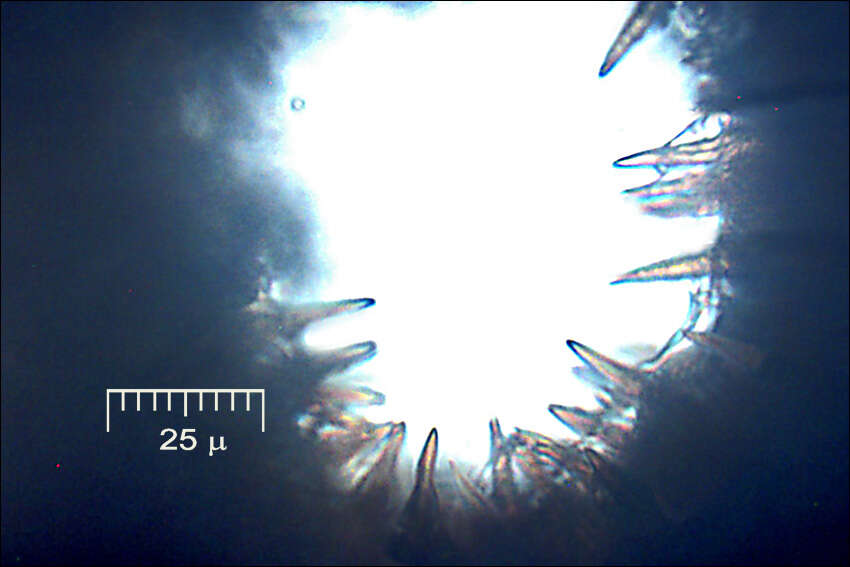
Phellinus ferruginosus, syn.: Polyporus ferruginosusRusty Pore crustSlo.: rjasti plutaPore transversal cross-section with abundant hymenial setae projecting well above hymenium.Dat.: Sept. 26. 2013Lat.: 46.36151 Long.: 13.70434Code: Bot_753/2013_DSC8066Habitat: Trees overgrown former grassland; dominant species Ailanthus altissima, Fraxinus ornus, Corylus avellana, Fagus sylvatica, Juglans regia, Tilia sp., Prunus domestica; next to an abandoned farmhouse; flat terrain, calcareous ground; full shade, quite humid and relatively warm place, partly protected from direct rain by tree canopies; average precipitation ~ 3.000 mm/year, average temperature 7-9 deg C, elevation 590 m (1.950 feet), alpine phytogeographical region. Substratum: vertical surface of dead, still standing trunk of Juglans regia partly still in bark.Place: Lower Trenta valley, between villages Soa and Trenta, near abandoned homestead 'Koc', Trenta 3, East Julian Alps, Posoje, Slovenia ECComments: Fungus growing on either side of partly peeling off bark of the tree, as well as on already decorticated surface of the trunk (less intensive); fungus was spreading on almost 2 m (7 feet) of the trunk height and in some places all around it. Trunk diameter about 50-60 cm; trama corky; smell indistinctive on rooting wood or earth; 5% KOH reaction on pore and sterile surfaces black; SP very faint, possibly whitish ?Spores smooth. Dimensions: 5.5 (SD = 0.2) x 3.5 (SD = 0.2) , Q = 1.56 (SD = 0.08), n = 30. Olympus CH20, NEA 100x/1.25, magnification 1.000 x, oil. Hymenial setae dimensions 43 (SD = 6.4) x 7.8 (SD = 0.7) , n = 29; generative hypha diameter 2.4 (SD = 0.2) , n = 6; skeletal hyphae diameter: 3.6 (SD = 0.6) , n = 6; setal hypha diameter 8.6 (SD = 0.7) , n = 6; NEA 40x/0.65, magnification 400x, in water, congo red. AmScope MA500 digital camera.Herbarium: Mycotheca and lichen herbarium (LJU-Li) of Slovenian Forestry Institute, Vena pot 2, Ljubljana, Index Herbariorum LJFRef.:(1) L. Ryvarden, R.L. Gilbertson, European Polypores, part 2., Synopsis Fungorum 7., Fungiflora A/S (1994), p 486. (2) A. Bernicchia, Polyporaceae s.l., Fungi Europaei, Vol. 10., Edizioni Candusso (2005), p 407.(3) G.J. Krieglsteiner (Hrsg.), Die Grosspilze Baden-Wrttembergs, Band 5., Ulmer (2000), p 451. (4) J. Breitenbach, F. Kraenzlin, Eds., Fungi of Switzerland, Vol.2. Verlag Mykologia (1984), p258. (5) Lowe, J.L. 1966. Polyporaceae of North America. The genus Poria. State University College of Forestry at Syracuse University. 90:1-183, available at
www.mycobank.org.
-
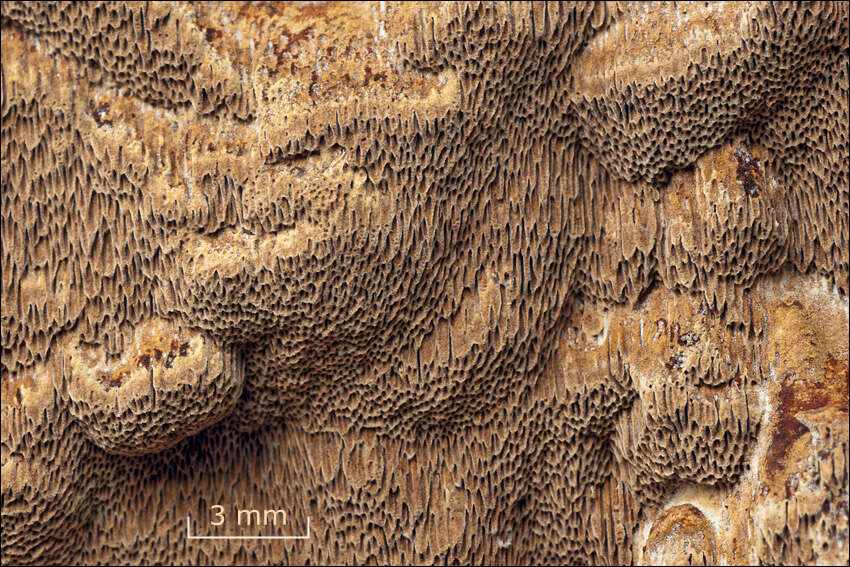
Phellinus ferruginosus, syn.: Polyporus ferruginosusRusty Pore crustSlo.: rjasti plutaDat.: Sept. 26. 2013Lat.: 46.36151 Long.: 13.70434Code: Bot_753/2013_DSC8066Habitat: Trees overgrown former grassland; dominant species Ailanthus altissima, Fraxinus ornus, Corylus avellana, Fagus sylvatica, Juglans regia, Tilia sp., Prunus domestica; next to an abandoned farmhouse; flat terrain, calcareous ground; full shade, quite humid and relatively warm place, partly protected from direct rain by tree canopies; average precipitation ~ 3.000 mm/year, average temperature 7-9 deg C, elevation 590 m (1.950 feet), alpine phytogeographical region. Substratum: vertical surface of dead, still standing trunk of Juglans regia partly still in bark.Place: Lower Trenta valley, between villages Soa and Trenta, near abandoned homestead 'Koc', Trenta 3, East Julian Alps, Posoje, Slovenia ECComments: Fungus growing on either side of partly peeling off bark of the tree, as well as on already decorticated surface of the trunk (less intensive); fungus was spreading on almost 2 m (7 feet) of the trunk height and in some places all around it. Trunk diameter about 50-60 cm; trama corky; smell indistinctive on rooting wood or earth; 5% KOH reaction on pore and sterile surfaces black; SP very faint, possibly whitish ?Spores smooth. Dimensions: 5.5 (SD = 0.2) x 3.5 (SD = 0.2) , Q = 1.56 (SD = 0.08), n = 30. Olympus CH20, NEA 100x/1.25, magnification 1.000 x, oil. Hymenial setae dimensions 43 (SD = 6.4) x 7.8 (SD = 0.7) , n = 29; generative hypha diameter 2.4 (SD = 0.2) , n = 6; skeletal hyphae diameter: 3.6 (SD = 0.6) , n = 6; setal hypha diameter 8.6 (SD = 0.7) , n = 6; NEA 40x/0.65, magnification 400x, in water, congo red. AmScope MA500 digital camera.Herbarium: Mycotheca and lichen herbarium (LJU-Li) of Slovenian Forestry Institute, Vena pot 2, Ljubljana, Index Herbariorum LJFRef.:(1) L. Ryvarden, R.L. Gilbertson, European Polypores, part 2., Synopsis Fungorum 7., Fungiflora A/S (1994), p 486. (2) A. Bernicchia, Polyporaceae s.l., Fungi Europaei, Vol. 10., Edizioni Candusso (2005), p 407.(3) G.J. Krieglsteiner (Hrsg.), Die Grosspilze Baden-Wrttembergs, Band 5., Ulmer (2000), p 451. (4) J. Breitenbach, F. Kraenzlin, Eds., Fungi of Switzerland, Vol.2. Verlag Mykologia (1984), p258. (5) Lowe, J.L. 1966. Polyporaceae of North America. The genus Poria. State University College of Forestry at Syracuse University. 90:1-183, available at
www.mycobank.org.
-
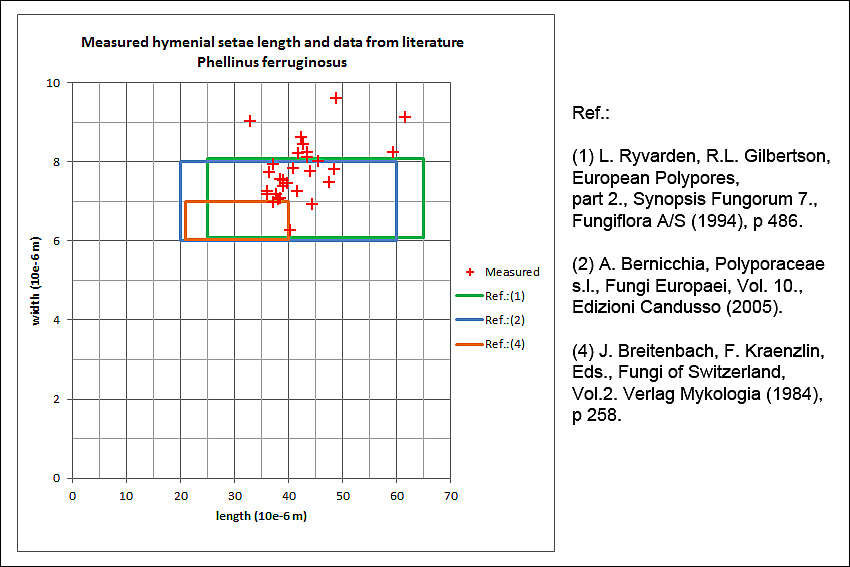
Phellinus ferruginosus, syn.: Polyporus ferruginosusRusty Pore crustSlo.: rjasti plutaHymenial setae length statistic and comparison with data from literature.Dat.: Sept. 26. 2013Lat.: 46.36151 Long.: 13.70434Code: Bot_753/2013_DSC8066Habitat: Trees overgrown former grassland; dominant species Ailanthus altissima, Fraxinus ornus, Corylus avellana, Fagus sylvatica, Juglans regia, Tilia sp., Prunus domestica; next to an abandoned farmhouse; flat terrain, calcareous ground; full shade, quite humid and relatively warm place, partly protected from direct rain by tree canopies; average precipitation ~ 3.000 mm/year, average temperature 7-9 deg C, elevation 590 m (1.950 feet), alpine phytogeographical region. Substratum: vertical surface of dead, still standing trunk of Juglans regia partly still in bark.Place: Lower Trenta valley, between villages Soa and Trenta, near abandoned homestead 'Koc', Trenta 3, East Julian Alps, Posoje, Slovenia ECComments: Fungus growing on either side of partly peeling off bark of the tree, as well as on already decorticated surface of the trunk (less intensive); fungus was spreading on almost 2 m (7 feet) of the trunk height and in some places all around it. Trunk diameter about 50-60 cm; trama corky; smell indistinctive on rooting wood or earth; 5% KOH reaction on pore and sterile surfaces black; SP very faint, possibly whitish ?Spores smooth. Dimensions: 5.5 (SD = 0.2) x 3.5 (SD = 0.2) , Q = 1.56 (SD = 0.08), n = 30. Olympus CH20, NEA 100x/1.25, magnification 1.000 x, oil. Hymenial setae dimensions 43 (SD = 6.4) x 7.8 (SD = 0.7) , n = 29; generative hypha diameter 2.4 (SD = 0.2) , n = 6; skeletal hyphae diameter: 3.6 (SD = 0.6) , n = 6; setal hypha diameter 8.6 (SD = 0.7) , n = 6; NEA 40x/0.65, magnification 400x, in water, congo red. AmScope MA500 digital camera.Herbarium: Mycotheca and lichen herbarium (LJU-Li) of Slovenian Forestry Institute, Vena pot 2, Ljubljana, Index Herbariorum LJFRef.:(1) L. Ryvarden, R.L. Gilbertson, European Polypores, part 2., Synopsis Fungorum 7., Fungiflora A/S (1994), p 486. (2) A. Bernicchia, Polyporaceae s.l., Fungi Europaei, Vol. 10., Edizioni Candusso (2005), p 407.(3) G.J. Krieglsteiner (Hrsg.), Die Grosspilze Baden-Wrttembergs, Band 5., Ulmer (2000), p 451. (4) J. Breitenbach, F. Kraenzlin, Eds., Fungi of Switzerland, Vol.2. Verlag Mykologia (1984), p258. (5) Lowe, J.L. 1966. Polyporaceae of North America. The genus Poria. State University College of Forestry at Syracuse University. 90:1-183, available at
www.mycobank.org.
-

Phellinus ferruginosus, syn.: Polyporus ferruginosusRusty Pore crustSlo.: rjasti plutaDat.: Sept. 26. 2013Lat.: 46.36151 Long.: 13.70434Code: Bot_753/2013_DSC8066Habitat: Trees overgrown former grassland; dominant species Ailanthus altissima, Fraxinus ornus, Corylus avellana, Fagus sylvatica, Juglans regia, Tilia sp., Prunus domestica; next to an abandoned farmhouse; flat terrain, calcareous ground; full shade, quite humid and relatively warm place, partly protected from direct rain by tree canopies; average precipitation ~ 3.000 mm/year, average temperature 7-9 deg C, elevation 590 m (1.950 feet), alpine phytogeographical region. Substratum: vertical surface of dead, still standing trunk of Juglans regia partly still in bark.Place: Lower Trenta valley, between villages Soa and Trenta, near abandoned homestead 'Koc', Trenta 3, East Julian Alps, Posoje, Slovenia ECComments: Fungus growing on either side of partly peeling off bark of the tree, as well as on already decorticated surface of the trunk (less intensive); fungus was spreading on almost 2 m (7 feet) of the trunk height and in some places all around it. Trunk diameter about 50-60 cm; trama corky; smell indistinctive on rooting wood or earth; 5% KOH reaction on pore and sterile surfaces black; SP very faint, possibly whitish ?Spores smooth. Dimensions: 5.5 (SD = 0.2) x 3.5 (SD = 0.2) , Q = 1.56 (SD = 0.08), n = 30. Olympus CH20, NEA 100x/1.25, magnification 1.000 x, oil. Hymenial setae dimensions 43 (SD = 6.4) x 7.8 (SD = 0.7) , n = 29; generative hypha diameter 2.4 (SD = 0.2) , n = 6; skeletal hyphae diameter: 3.6 (SD = 0.6) , n = 6; setal hypha diameter 8.6 (SD = 0.7) , n = 6; NEA 40x/0.65, magnification 400x, in water, congo red. AmScope MA500 digital camera.Herbarium: Mycotheca and lichen herbarium (LJU-Li) of Slovenian Forestry Institute, Vena pot 2, Ljubljana, Index Herbariorum LJFRef.:(1) L. Ryvarden, R.L. Gilbertson, European Polypores, part 2., Synopsis Fungorum 7., Fungiflora A/S (1994), p 486. (2) A. Bernicchia, Polyporaceae s.l., Fungi Europaei, Vol. 10., Edizioni Candusso (2005), p 407.(3) G.J. Krieglsteiner (Hrsg.), Die Grosspilze Baden-Wrttembergs, Band 5., Ulmer (2000), p 451. (4) J. Breitenbach, F. Kraenzlin, Eds., Fungi of Switzerland, Vol.2. Verlag Mykologia (1984), p258. (5) Lowe, J.L. 1966. Polyporaceae of North America. The genus Poria. State University College of Forestry at Syracuse University. 90:1-183, available at
www.mycobank.org.
-
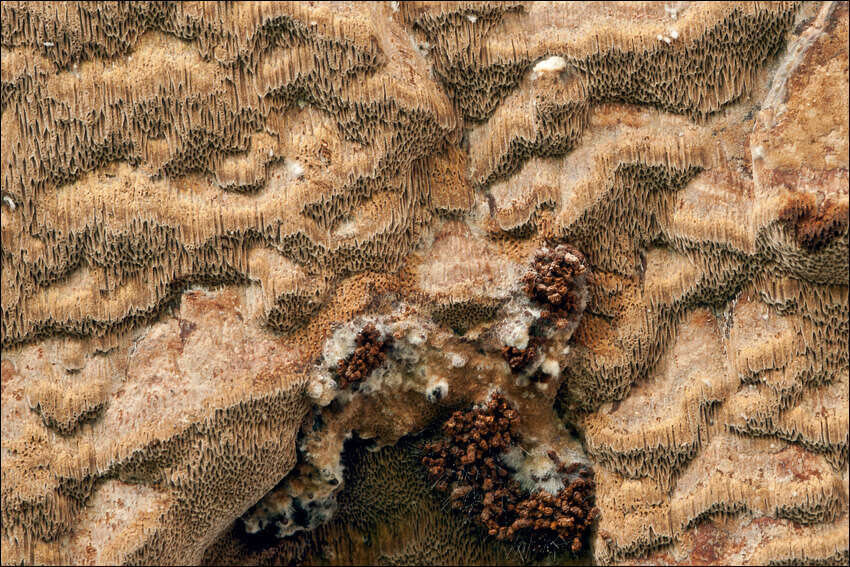
Phellinus ferruginosus, syn.: Polyporus ferruginosusRusty Pore crustSlo.: rjasti plutaDat.: Sept. 26. 2013Lat.: 46.36151 Long.: 13.70434Code: Bot_753/2013_DSC8066Habitat: Trees overgrown former grassland; dominant species Ailanthus altissima, Fraxinus ornus, Corylus avellana, Fagus sylvatica, Juglans regia, Tilia sp., Prunus domestica; next to an abandoned farmhouse; flat terrain, calcareous ground; full shade, quite humid and relatively warm place, partly protected from direct rain by tree canopies; average precipitation ~ 3.000 mm/year, average temperature 7-9 deg C, elevation 590 m (1.950 feet), alpine phytogeographical region. Substratum: vertical surface of dead, still standing trunk of Juglans regia partly still in bark.Place: Lower Trenta valley, between villages Soa and Trenta, near abandoned homestead 'Koc', Trenta 3, East Julian Alps, Posoje, Slovenia ECComments: Fungus growing on either side of partly peeling off bark of the tree, as well as on already decorticated surface of the trunk (less intensive); fungus was spreading on almost 2 m (7 feet) of the trunk height and in some places all around it. Trunk diameter about 50-60 cm; trama corky; smell indistinctive on rooting wood or earth; 5% KOH reaction on pore and sterile surfaces black; SP very faint, possibly whitish ?Spores smooth. Dimensions: 5.5 (SD = 0.2) x 3.5 (SD = 0.2) , Q = 1.56 (SD = 0.08), n = 30. Olympus CH20, NEA 100x/1.25, magnification 1.000 x, oil. Hymenial setae dimensions 43 (SD = 6.4) x 7.8 (SD = 0.7) , n = 29; generative hypha diameter 2.4 (SD = 0.2) , n = 6; skeletal hyphae diameter: 3.6 (SD = 0.6) , n = 6; setal hypha diameter 8.6 (SD = 0.7) , n = 6; NEA 40x/0.65, magnification 400x, in water, congo red. AmScope MA500 digital camera.Herbarium: Mycotheca and lichen herbarium (LJU-Li) of Slovenian Forestry Institute, Vena pot 2, Ljubljana, Index Herbariorum LJFRef.:(1) L. Ryvarden, R.L. Gilbertson, European Polypores, part 2., Synopsis Fungorum 7., Fungiflora A/S (1994), p 486. (2) A. Bernicchia, Polyporaceae s.l., Fungi Europaei, Vol. 10., Edizioni Candusso (2005), p 407.(3) G.J. Krieglsteiner (Hrsg.), Die Grosspilze Baden-Wrttembergs, Band 5., Ulmer (2000), p 451. (4) J. Breitenbach, F. Kraenzlin, Eds., Fungi of Switzerland, Vol.2. Verlag Mykologia (1984), p258. (5) Lowe, J.L. 1966. Polyporaceae of North America. The genus Poria. State University College of Forestry at Syracuse University. 90:1-183, available at
www.mycobank.org.
-

Phellinus ferruginosus, syn.: Polyporus ferruginosusRusty Pore crustSlo.: rjasti pluta Hyphal system (as far as my understanding allows). Green arrow - generative hypha, violet arrow - skeletal hypha and red arrow - a fraction of setal hyphae.Dat.: Sept. 26. 2013Lat.: 46.36151 Long.: 13.70434Code: Bot_753/2013_DSC8066Habitat: Trees overgrown former grassland; dominant species Ailanthus altissima, Fraxinus ornus, Corylus avellana, Fagus sylvatica, Juglans regia, Tilia sp., Prunus domestica; next to an abandoned farmhouse; flat terrain, calcareous ground; full shade, quite humid and relatively warm place, partly protected from direct rain by tree canopies; average precipitation ~ 3.000 mm/year, average temperature 7-9 deg C, elevation 590 m (1.950 feet), alpine phytogeographical region. Substratum: vertical surface of dead, still standing trunk of Juglans regia partly still in bark.Place: Lower Trenta valley, between villages Soa and Trenta, near abandoned homestead 'Koc', Trenta 3, East Julian Alps, Posoje, Slovenia ECComments: Fungus growing on either side of partly peeling off bark of the tree, as well as on already decorticated surface of the trunk (less intensive); fungus was spreading on almost 2 m (7 feet) of the trunk height and in some places all around it. Trunk diameter about 50-60 cm; trama corky; smell indistinctive on rooting wood or earth; 5% KOH reaction on pore and sterile surfaces black; SP very faint, possibly whitish ?Spores smooth. Dimensions: 5.5 (SD = 0.2) x 3.5 (SD = 0.2) , Q = 1.56 (SD = 0.08), n = 30. Olympus CH20, NEA 100x/1.25, magnification 1.000 x, oil. Hymenial setae dimensions 43 (SD = 6.4) x 7.8 (SD = 0.7) , n = 29; generative hypha diameter 2.4 (SD = 0.2) , n = 6; skeletal hyphae diameter: 3.6 (SD = 0.6) , n = 6; setal hypha diameter 8.6 (SD = 0.7) , n = 6; NEA 40x/0.65, magnification 400x, in water, congo red. AmScope MA500 digital camera.Herbarium: Mycotheca and lichen herbarium (LJU-Li) of Slovenian Forestry Institute, Vena pot 2, Ljubljana, Index Herbariorum LJFRef.:(1) L. Ryvarden, R.L. Gilbertson, European Polypores, part 2., Synopsis Fungorum 7., Fungiflora A/S (1994), p 486. (2) A. Bernicchia, Polyporaceae s.l., Fungi Europaei, Vol. 10., Edizioni Candusso (2005), p 407.(3) G.J. Krieglsteiner (Hrsg.), Die Grosspilze Baden-Wrttembergs, Band 5., Ulmer (2000), p 451. (4) J. Breitenbach, F. Kraenzlin, Eds., Fungi of Switzerland, Vol.2. Verlag Mykologia (1984), p258. (5) Lowe, J.L. 1966. Polyporaceae of North America. The genus Poria. State University College of Forestry at Syracuse University. 90:1-183, available at
www.mycobank.org.



